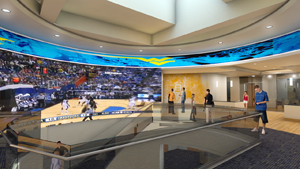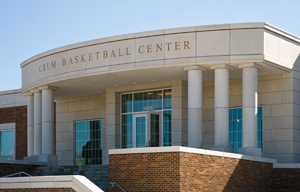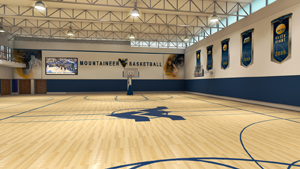In early January, the University of West Virginia will open its $23.6 million basketball practice facility in Morgantown, W.Va., filling a critical need for the Mountaineers’ men’s and women’s basketball programs.
Both teams now fight for practice time at WVU Coliseum, sharing the school’s 41-year-old arena with physical education classes, women’s volleyball and gymnastics, wrestling, college and high school graduations, and concerts.
The state-of-the-art practice facility and its 24/7 access for athletes, coaches and support staff will solve those headaches for men’s coach Bob Huggins and women’s coach Mike Carey. Big picture, though, it will serve a larger purpose.
For Huggins, the building’s hall of fame and video technology components will provide a valuable marketing tool for attracting blue-chippers to Morgantown, an otherwise gritty, blue-collar college town. West Virginia is not Kansas or Duke, traditional powerhouses where coaches Bill Self and Mike Krzyzewski can impress recruits by pointing to the multiple NCAA championship banners inside historic
 |
WVU’s new practice facility, shown in these renderings, will be a powerful recruiting tool.
Photos by: WVU |
Allen Fieldhouse and Cameron Indoor Stadium.
“It is not the space itself, but the messaging that is important,” said Jon Niemuth, design director for Aecom, West Virginia’s architect. “They have a solid arena and a winning tradition. But if you want to compete for national championships, you need something more.”
The same is true for other schools whose basketball teams need their own dedicated practice space to keep up in the “arms race” for college sports facilities. Five years ago, about a dozen Division I universities were planning or building basketball practice facilities. Now, the trend has exploded.
A partial list of practice facility projects covers Arizona State, Arkansas, Clemson, Connecticut, Drake, Georgetown, Indiana, Iowa, Kansas State, LSU, Mississippi State, Purdue, Richmond, Rutgers, South Florida, SMU, Texas A&M, Tulane, Washington and Washington State.
Some have opened in the past few years. Others are in the design phase, under construction or going through fundraising campaigns. Still others are part of long-term master plans covering all sports venues on campus.
If a school doesn’t have a basketball practice facility or a plan to build one, it is behind the curve. It is the one thing that everybody wants to separate themselves from the competition, Niemuth said.
For the Mountaineers, the “wow factor” required to compete against top programs will lie inside the walls of their new practice facility. Step inside the front door, and one of the first things recruits will see is memorabilia tied to Jerry West and “Hot” Rod Hundley, West Virginia’s two most famous basketball alums. A separate display will showcase the dozen players Huggins has sent to the NBA over the course of his 26-year coaching career.
The facility was more than a “want,” it was something the school badly needed, Huggins said.
“We can go in there any time, day or night, whenever the kids have time,” he said. Previously, if his players wanted to hone their shooting skills on their own outside of practice, they had to go to the school’s recreation center, which is open to all students.
In general, the cost to build college basketball practice facilities ranges from $10 million to $25 million, depending on the program and level of commitment to making these buildings stand out as a recruiting component, said Ryan Sickman, an associate principal at Populous.
Donors fund the projects, with larger gifts tied to naming rights for spaces within the facility and the building itself. At Iowa, for example, the Howard family donated $5 million as the lead gift toward the $20 million the school needed to have in hand before kicking off the project. In addition, Iowa signed seven-figure naming-rights deals with cable television provider Mediacom for Carver-Hawkeye Arena’s floor, and insurance company Aegon/Transamerica for the adjoining performance center.
Auburn and Oregon built practice facilities attached to new arenas that opened in 2010. The setup can save schools a few million dollars compared with building stand-alone structures, Sickman said.
Iowa folded its new basketball practice facility into a $47 million facelift of Carver-Hawkeye Arena. It includes an expansion of the Dan Gable Wrestling Complex at a school where, in recent years, wrestling has caught up in attendance with Iowa’s struggling basketball program.
The layout of practice facilities extends to hospitality on game days, with club lounges reserved for the projects’ chief donors. At Iowa’s new Dale and Marilyn Howard Family Pavilion, the 75,000-square-foot practice facility has two club rooms for donors and other major supporters of basketball and wrestling. The larger of the two rooms seats up to 500 people. Both spaces have a “sports bar feel” with televisions broadcasting other college basketball games across the country, said Iowa Athletic Director Gary Barta.
“If you take it a step further, these practice facilities are a huge asset for the university itself … for banquets and conferences to other events such as cheerleading camps,” said Mark Williams, a principal with HKS, the designer for SMU’s Crum Basketball Center in Dallas.
Crum Basketball Center opened in February 2008, and its amenities are of such high quality that the Dallas Mavericks
 |
The Dallas Mavericks hold their training camp at SMU’s Crum Basketball Center.
Photo by: HKS |
moved their training camp on campus later that year. The center, five miles from downtown Dallas, was not originally designed to accommodate the NBA, but after checking out the facility, the Mavericks felt it was a major upgrade over the team’s single-court setup at American Airlines Center, said SMU Athletic Director Steve Orsini. Plus, visiting NBA teams use Crum Basketball Center for their game-day shoot-arounds, Orsini said.
Orsini refused to say how much SMU charges the Mavericks to rent the facility, but it is “not an arm and a leg,” he said. “We turn events away, but those rentals are not our primary business. This building is for our student athletes.”
SMU charges $500 plus expenses to rent the building for one day, and $100 an hour plus expenses for use of one court, according to the school’s athletics website.
Kentucky, among college basketball’s bluebloods, opened the $30 million Joe Craft Center in January 2007, still the most expensive basketball practice facility to date. Soon after it opened, the Great Recession took hold and the bottom dropped out of the construction market, reducing labor and material costs to bargain-basement prices.
West Virginia took advantage of the economic downturn for its project that began four years ago when Huggins toured Kentucky’s practice facility, Louisville’s on-campus practice faciliy, and the one tied to Virginia’s John Paul Jones Arena.
“When we went on that tour, Huggins’ challenge to us was always, ‘How does this compare?’” Niemuth said.
“Was it the biggest, the best, the nicest?” he said. “If the answer was no, we had to move on. It was so important in that respect because the lead gifts were contingent on the practice facility being the best in the Big East Conference.”
The group saw Craft Center’s video wall at Kentucky, cutting-edge at the time it opened. Separately, Niemuth visited other schools, where 60-inch screens were common. To top that, West Virginia went huge, installing five 103-inch plasma screens, including one in each team’s video theater and one in the Robinson-Petroplus Basketball Hall of Tradition inside the facility’s front door.
Elsewhere, officials installed a Panasonic 6-millimeter LED video board, 25 feet high and 14 feet wide, and above that screen, an LED ribbon board, connecting the offices to the team level.
Video aside, the practice facility’s centerpiece will be a 20-foot-high net made with aluminum and a translucent acrylic material, said April Messerly, West Virginia’s director of facilities and operations. It will glow from the inside and serve as the building’s focal point. Supporting the West and Hundley displays will be a 2010 Final Four uniform, a warm-up suit from the 1940s and an original hoop from the old Stansbury Hall gym on campus. All those items will help tell the story of WVU’s basketball legacy, an important part of the project for Huggins, a West Virginia graduate.
“The other part of the equation is that there was no place to house the history of West Virginia basketball,” Huggins said.






